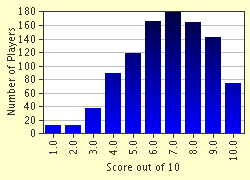Quiz Answer Key and Fun Facts
1. Just about everyone has heard of haemoglobin, which is the compound in our blood that makes it red. What is the "haeme" portion of the molecule best described as?
2. DNA (deoxyribonucleic acid) is the molecule that carries our genetic code. In 1953, James Watson and Francis Crick proposed that DNA's structure is that of a double helix. What is the form of bonding that enables this double helix to be formed?
3. Enzymes are biomolecules that enable the body to perform reactions that chemists can also do in the lab. However, the body has to do without heating mantles and reagents such as organic solvents and sodium hydroxide! This means that enzymes are remarkable biological catalysts, carrying out chemical reactions at physiological temperature and pH. A subclass of enzyme is the lipases. What kind of chemical reaction do lipases catalyse?
4. Proteins are biological polymers that play all sorts of roles within our bodies. Haemoglobin is a protein, as are insulin and keratin. What is the general building block common to all proteins?
5. We know that we need certain vitamins to stay healthy. Each vitamin has its own special role to play within our bodies to make sure they function as they should. Beta-carotene, the pigment that gives carrots their orange colour, is an important source of which vitamin that helps us see?
6. Our stomach plays an important part in the digestion process. What is the name of the acid present in our stomach used for digestion?
7. The digestive process breaks down food into small molecules. Carbohydrates are broken down into glucose and other sugars, which are in turn degraded further in preparation for entry into the citric acid cycle. The citric acid cycle produces energy and what gas?
8. If you happen to ingest a small amount of something toxic, which of the following is the most likely way your body will try to reduce its toxic effect on you?
9. Prostaglandins are biosynthesised in our bodies from arachidonic acid, a fatty acid (a fatty acid is a carboxylic acid featuring a long carbon chain). Which of the following is true of prostaglandins?
10. I've already mentioned proteins in this quiz as being biological polymers. Protein molecules are extremely large and as a consequence need more to hold them in a particular shape than just the bonds between the subunits. This is often accomplished by forming a special kind of bridge using two atoms of which element?
Source: Author
NatalieW
This quiz was reviewed by FunTrivia editor
crisw before going online.
Any errors found in FunTrivia content are routinely corrected through our feedback system.

